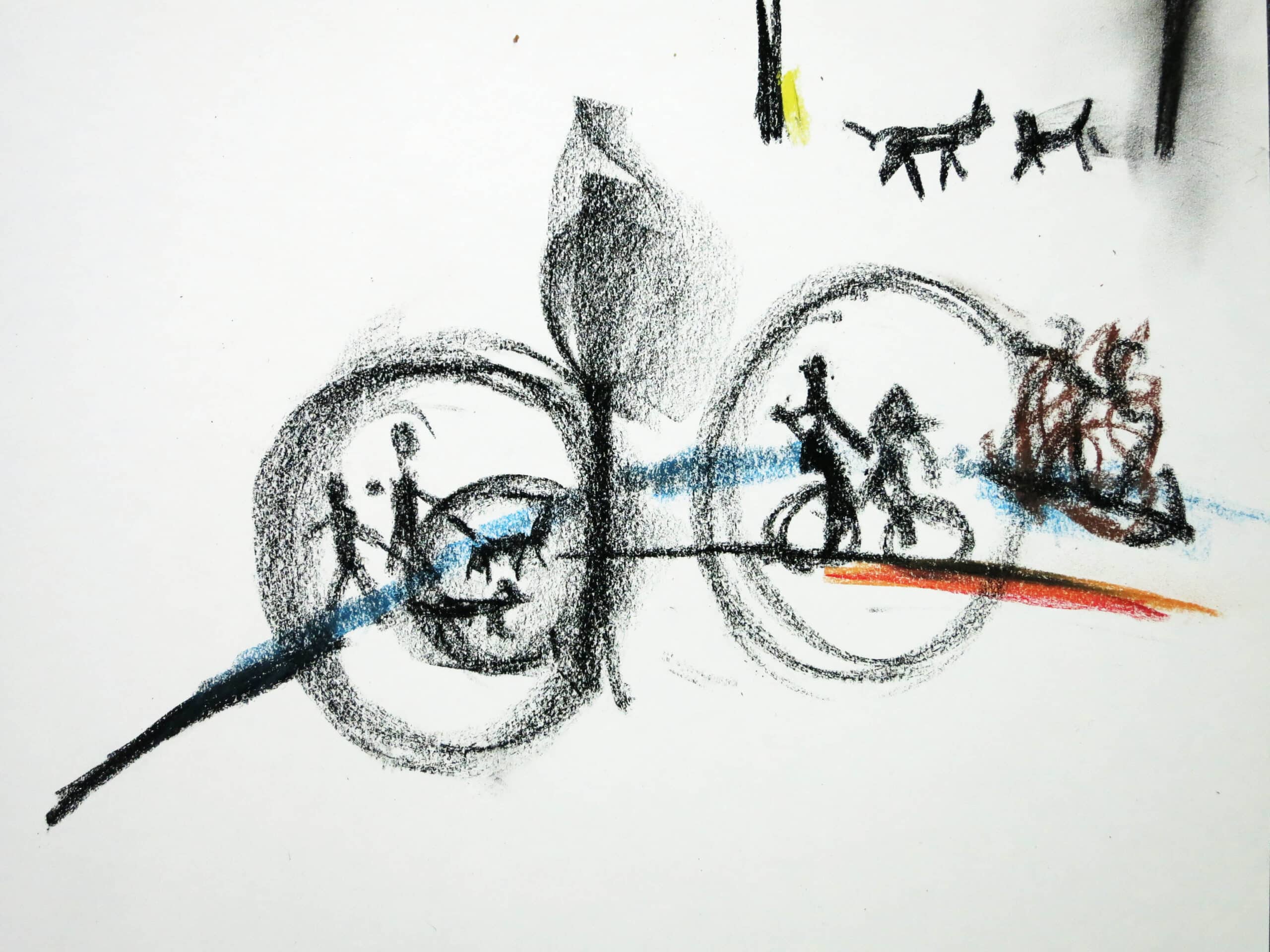Due to different regimes of lockdown, people are at this moment challenged in their mobilities. Both outdoor and indoor spaces have changed. During the workshop The City as Performative Object, (April and May 2020 Rietveld Academy and KABK interfaculty) we will use this worldwide provocation as an opportunity, it will be the ‘material’, both on a personal and global scale.
This workshop was part of our (Esther and Ivar’s) research, exploring the built environment as a space that is produced by mobilities. For this edition of the workshop, it was done from within home situations, due to the 2020 spring corona lockdown. Students experimented with Zoom (video call) to collaborate on experiments

Ella: Looking out of the window, I saw not many repetitions. I did look at the shadows: How they repeat. It turned out to be more detailed: also in shadows of the leaves. The shadow changes if an object passes but returns to the original state. If you don’t look at it for 5 min, it has changed
Farah: We used the zoom interface to experiment: one person makes a repetitive movement for the camera ( 15 sec) and then left the camera view empty so that the others could imagine the movement from memory. It was nice to be physical.
Nika: we experimented with our respected window views. We looked at the predictability of the movements we saw. But the camera experiments were more interesting: to visualize the movements from memory. It also showed that the three of them had different ways of producing Move-Memory. It works differently with repetitive and non-repetitive movements.

Ann-Flo and Dasha: we were productive. We were in very different environments: also not visible things are moving and have an impact on the space—for example, a helicopter. Ann-Floo was alert to find more invisible Move-Categories. She noticed a house with a lot of camera’s that protect itself from uninvited movements—suspicion and shame as separate Move-Categories. There was something noisy that was attracting people to deviate from their path, but that An-Flo could not see. Ann-Flo saw a lot of Move-Categories that were coverable and could mutate into something diff. Example: Guys that were holding trollies but used them as skates. Somebody walking with a bicycle at any point can become a cyclist.
Part of the workshop consisted of watching Chantal Akerman’s 1975 film Jeanne Dielman, 23 quai du Commerce, 1080 Bruxelles I found this film resonating with the lockdown situation.
I asked the students to watch this 3:30 min film online, at home, with a notebook. The Move-Lexicon was used to describe the experience of watching the film.

Nika’s mapping

Ann-Flo made a floorplan of Jeanne Dielman’s apartment
Ella:
• Life consisting of a series of daily life rituals: well trained / coordinated move-acts
• Jeanne symbolising a very individual unit of move-entity
• Move-acts happening inside the house, seem to have a similar purpose as move-acts within public space, almost like she was being watched / controlled by some sort of public figure
• Almost no pause between the move-acts (until the end when her daily structure breaks more and more apart), like one never ending move-act
• Jeanne: active move-entity, Sylvain: passive move-entity
• Even the Camera shots seem to follow certain move-treads, in the beginning mainly after-tread (repetition of similar frames) and in the end a few new angles along with new storyline (new-treads)
• Perhaps there is a variety of extremities regarding after-treads (repetitional movements)
• Some seem to happen more often and better internalized than others (for example movements inside the house compared to movements outside), yet still holding a similar sense of repetition
• Outside elements influencing our movement routines: eg. Search for a new button because of the coat from her sister -> new movements, new-tread
• Repetitional lights in the living room, what is the source? How does our environment reflect/represent our move behavior?
• How conscious are we about our movement routines? How easy/ what does it take to break them?
• What is our reasoning/motivation of our move-acts or even becoming a move entity?
Ella:
• Life consisting of a series of daily life rituals: well trained / coordinated move-acts
• Jeanne symbolising a very individual unit of move-entity
• Move-acts happening inside the house, seem to have a similar purpose as move-acts within public space, almost like she was being watched / controlled by some sort of public figure
• Almost no pause between the move-acts (until the end when her daily structure breaks more and more apart), like one never ending move-act
• Jeanne: active move-entity, Sylvain: passive move-entity
• Even the Camera shots seem to follow certain move-treads, in the beginning mainly after-tread (repetition of similar frames) and in the end a few new angles along with new storyline (new-treads)
• Perhaps there is a variety of extremities regarding after-treads (repetitional movements)
• Some seem to happen more often and better internalized than others (for example movements inside the house compared to movements outside), yet still holding a similar sense of repetition
• Outside elements influencing our movement routines: eg. Search for a new button because of the coat from her sister -> new movements, new-tread
• Repetitional lights in the living room, what is the source? How does our environment reflect/represent our move behavior?
• How conscious are we about our movement routines? How easy/ what does it take to break them?
• What is our reasoning/motivation of our move-acts or even becoming a move entity?